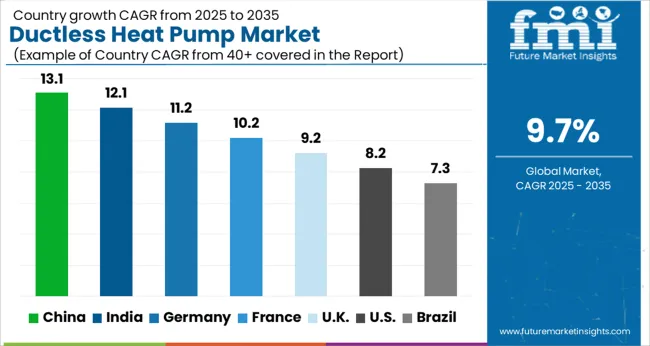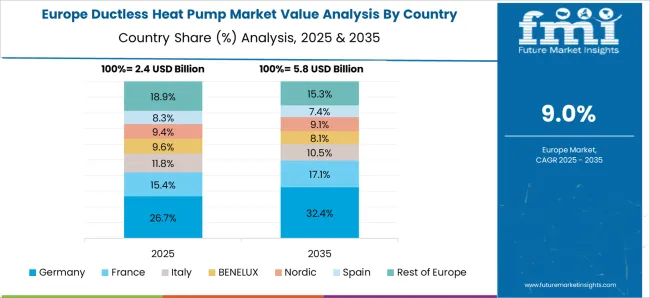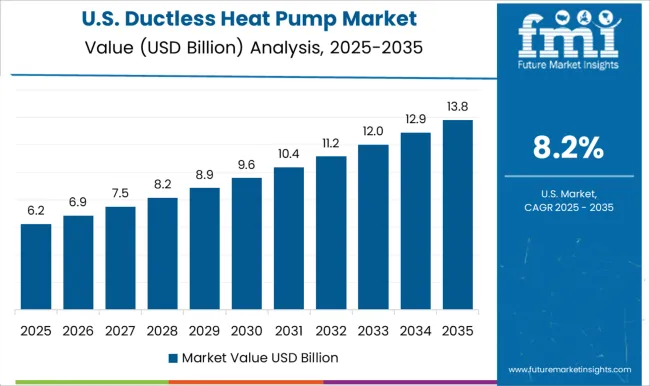The ductless heat pump market is estimated to be valued at USD 11.2 billion in 2025 and is projected to reach USD 28.2 billion by 2035, registering a compound annual growth rate (CAGR) of 9.7% over the forecast period. Growth is being fueled by increasing demand for energy-efficient, flexible heating and cooling systems across residential, commercial, and light industrial applications. Unlike traditional HVAC systems, ductless heat pumps offer easier installation, lower energy losses, and zoning capabilities, making them highly attractive for retrofitting projects and buildings without existing ductwork.
Market momentum is further supported by rising awareness of sustainability, government incentives for energy-efficient technologies, and stricter building codes emphasizing reduced carbon emissions. Asia-Pacific, led by China and Japan, is expected to dominate due to high adoption in densely populated urban areas, while North America and Europe are witnessing growing demand driven by green building initiatives and the replacement of conventional systems. However, challenges such as higher upfront installation costs and performance limitations in extreme climates may restrain adoption in certain regions. Despite this, ongoing technological advancements, such as variable refrigerant flow systems, integration with smart home solutions, and improved cold-climate performance, are expected to mitigate these barriers.
| Metric | Value |
|---|---|
| Ductless Heat Pump Market Estimated Value in (2025 E) | USD 11.2 billion |
| Ductless Heat Pump Market Forecast Value in (2035 F) | USD 28.2 billion |
| Forecast CAGR (2025 to 2035) | 9.7% |
A shift toward sustainable residential construction, coupled with stricter energy efficiency mandates, is contributing to greater adoption of ductless systems. These systems are being increasingly preferred for their minimal installation disruption, zoning flexibility, and reduced energy consumption compared to conventional HVAC systems. Rising electricity costs and greater awareness regarding carbon emissions have further driven consumer and institutional interest in heat pump technology.
Additionally, product advancements in inverter-driven compressors and smart control integration are expected to sustain future market momentum. As both residential and commercial sectors prioritize environmentally responsible heating and cooling, ductless systems are likely to maintain a strong foothold in global deployment scenarios.
The ductless heat pump market is segmented by application, system, and geographic regions. By application, the ductless heat pump market is divided into Residential and Commercial. In terms of system, the ductless heat pump market is classified into multi-zone and single-zone. Regionally, the ductless heat pump industry is classified into North America, Latin America, Western Europe, Eastern Europe, Balkan & Baltic Countries, Russia & Belarus, Central Asia, East Asia, South Asia & Pacific, and the Middle East & Africa.
The residential application segment is expected to hold 63.2% of the overall Ductless Heat Pump market revenue in 2025, making it the dominant application area. This leadership position is being supported by growing residential construction activity, particularly in regions promoting low-carbon housing. Homeowners are increasingly opting for ductless systems due to their easy installation, zoning flexibility, and energy-saving potential.
The ability to retrofit existing structures without major renovations has enhanced the segment’s appeal in both new and aging homes. Rising utility bills and consumer preference for systems offering year-round comfort with minimal maintenance have further driven this segment’s uptake.
Additionally, government incentives for energy-efficient home upgrades are playing a crucial role in encouraging the replacement of outdated heating and cooling units with ductless heat pump solutions. As climate regulations continue to tighten, residential demand is anticipated to maintain strong momentum across developed and emerging economies.
The multi-zone system type is projected to account for 58.7% of the total Ductless Heat Pump market revenue in 2025, emerging as the leading system configuration. This dominance is being attributed to the increasing preference for systems that allow independent temperature control in multiple rooms or areas.
Multi-zone systems are being chosen for their ability to provide tailored comfort while improving energy efficiency by avoiding over-conditioning unused spaces. The growth of this segment has also been influenced by rising demand in large homes, apartments, and small commercial spaces where centralized systems may be less cost-effective or practical.
Technological enhancements enabling seamless control through mobile applications and smart thermostats have further enhanced the usability of multi-zone solutions. As energy codes and building standards continue to emphasize zone-specific efficiency, multi-zone ductless systems are expected to gain further traction as a scalable and cost-efficient solution.
The ductless heat pump market is experiencing growth due to rising demand for energy efficiency, green building solutions, and adoption in residential and commercial sectors. Manufacturers are focusing on improving system performance and expanding their product lines to stay competitive.
The demand for ductless heat pumps is primarily driven by the increasing focus on energy efficiency across residential and commercial sectors. These systems provide both heating and cooling solutions, helping to reduce energy consumption compared to traditional HVAC units. As energy prices continue to rise, consumers are seeking more cost-effective alternatives, and ductless heat pumps are well-suited for this demand due to their efficiency and lower operational costs. The growing emphasis on reducing overall energy expenditure and minimizing carbon footprints further supports the widespread adoption of these systems. Governments in many regions also offer incentives for energy-efficient technologies, which accelerates market growth.
Ductless heat pumps are gaining significant traction in the green building market. As construction standards evolve and more buildings focus on low-energy consumption, these systems provide an ideal solution for new and retrofit projects. Their small footprint and ability to be integrated into existing buildings make them an attractive option. The demand for environmentally friendly building practices has spurred an increase in the installation of ductless heat pumps. Builders, architects, and property developers are increasingly turning to these systems to meet green building certification requirements and provide residents or businesses with more efficient heating and cooling options.
Ductless heat pumps are becoming a preferred choice in both residential and commercial sectors due to their adaptability and efficiency. In residential applications, homeowners are opting for these systems for their ability to heat and cool rooms without the need for extensive ductwork. In commercial spaces, especially in buildings with multiple zones or irregular layouts, ductless systems offer flexibility, allowing for individualized temperature control. This adaptability in both sectors, along with their low maintenance costs, has increased demand across various building types. The growing preference for personalized comfort in both homes and businesses will continue to drive adoption.
The competitive landscape for ductless heat pumps is becoming increasingly dynamic as more players enter the market. Leading manufacturers are focusing on enhancing system performance, ease of installation, and affordability to capture a larger market share. Companies are also focusing on expanding their product lines to cater to specific needs, such as multi-zone units for larger homes or commercial spaces. The increasing demand for smart home integration is driving manufacturers to develop systems that can be controlled remotely or via mobile apps. The competition among established players and new entrants is accelerating innovation and making these systems more accessible to a wider range of consumers

The ductless heat pump market is projected to grow globally at a CAGR of 9.7% from 2025 to 2035, driven by the increasing demand for energy-efficient heating and cooling solutions in both residential and commercial sectors. China leads with a CAGR of 13.1%, supported by the rapid growth in residential construction, rising consumer demand for energy-efficient solutions, and government initiatives promoting clean energy alternatives. India follows closely at 12.1%, driven by expanding urbanization, growing middle-class populations, and government policies encouraging energy-efficient technologies. France sees 10.2% growth, spurred by its emphasis on reducing energy consumption in the residential and commercial sectors. The United Kingdom grows at 9.2%, supported by incentives for low-carbon heating systems and government mandates on reducing emissions. The United States shows steady growth at 8.2%, with increasing demand for ductless heat pumps driven by eco-conscious consumers, particularly in regions with extreme temperatures. This growth outlook emphasizes the increasing adoption of energy-efficient and low-emission systems in residential and commercial sectors, particularly in Asia and Europe.
China is expected to grow at a CAGR of 13.1% during 2025–2035, well above the global average of 9.7%, driven by rapid urbanization, increasing demand for residential heating and cooling solutions, and government initiatives promoting energy efficiency. From 2020–2024, the CAGR stood at 10.5%, supported by strong domestic demand for energy-efficient systems and early adoption in urban areas. The step-up in the next decade is linked to a significant shift toward energy-efficient building technologies, especially in new urban developments, and government-backed incentives for residential energy-saving solutions. Local manufacturers are focusing on reducing installation costs and improving system efficiency to meet the growing demand from both urban and rural areas.
The CAGR for the United Kingdom is projected to be 9.2% during 2025–2035, slightly below the global growth rate of 9.7%. From 2020–2024, the CAGR was 7.5%, hindered initially by the high installation costs and limited awareness in certain regions. However, the next decade is expected to see stronger growth, driven by government incentives, rising energy costs, and increased focus on decarbonization in housing and commercial buildings. The shift toward electric heating systems like ductless heat pumps is essential as the UK looks to meet its carbon reduction targets. Both residential and commercial markets are expected to expand as more consumers and businesses adopt energy-efficient technologies.
India’s CAGR is projected at 12.1% during 2025–2035, compared to 8.6% during 2020–2024, signaling faster growth driven by expanding urbanization, increasing construction activities, and government incentives for energy-efficient solutions. The earlier period saw moderate growth due to high upfront costs of installation and lower awareness of ductless systems. The increase in the next decade is linked to rapid infrastructure development, rising disposable incomes, and strong government policy support for energy-efficient solutions in residential and commercial sectors. Industrial and commercial applications are also expected to contribute significantly to market growth as businesses adopt ductless systems to reduce energy consumption and maintenance costs.

Germany is projected to grow at a CAGR of 11.2% during 2025–2035, above the global market’s growth rate of 9.7%. From 2020–2024, the CAGR stood at 8.4%, driven by the country’s emphasis on energy efficiency in new buildings and renovations. The shift to higher growth in the next decade is driven by strong government mandates and subsidies for low-carbon technologies, making ductless heat pumps an attractive option for reducing energy consumption. Additionally, Germany’s focus on eco-friendly construction and energy-efficient retrofitting projects will continue to drive adoption in both the residential and commercial sectors. Manufacturers are responding with more affordable and highly efficient products to meet the growing demand.

The CAGR for the United States is projected to be 8.2% during 2025–2035, slightly below the global growth rate of 9.7%. From 2020–2024, the CAGR was 6.0%, driven primarily by early adoption in regions with extreme heating and cooling demands. Growth was initially slower due to the relatively higher upfront costs of ductless systems compared to traditional HVAC solutions. However, the market is expected to accelerate in the coming decade, driven by a focus on energy-efficient heating and cooling solutions as both residential and commercial sectors prioritize reducing energy consumption. Increasing interest in environmentally friendly solutions, coupled with government incentives, will further stimulate adoption. Additionally, the rise in electric vehicle integration and smart home technologies is expected to complement the demand for more energy-efficient and intelligent heating systems.
The ductless heat pump market is highly competitive, featuring a combination of global HVAC leaders and specialized manufacturers focusing on energy-efficient and flexible heating and cooling solutions. Daikin is a dominant player with its comprehensive range of ductless systems that integrate advanced technology for enhanced energy efficiency and environmental performance.
Carrier offers a wide selection of ductless heat pumps with innovative designs that emphasize low operational costs and minimal maintenance. Fujitsu General provides high-performance units known for their reliability and long service life, particularly in residential applications. Panasonic is recognized for integrating cutting-edge inverter technology into their ductless systems, delivering optimal comfort with reduced energy consumption. Samsung and LG focus on offering smart features and connectivity, enhancing the appeal of their ductless systems for modern homes and businesses looking for convenience and efficiency. Trane differentiates itself with its well-known brand reputation and commitment to delivering reliable, high-performance units suited for both residential and commercial applications.
Gree Electric Appliances and Lennox International provide a broad portfolio of customizable solutions, catering to diverse consumer needs in the heating and cooling space. Competitive strategies focus on integrating smart home features, improving energy efficiency, and expanding into emerging markets where the demand for eco-friendly and cost-effective heating solutions is increasing. Manufacturers are also focusing on delivering products with quiet operation, easy installation, and long-term durability to maintain a strong position in this growing market.
| Item | Value |
|---|---|
| Quantitative Units | USD 11.2 Billion |
| Application | Residential and Commercial |
| System | Multi zone and Single zone |
| Regions Covered | North America, Europe, Asia-Pacific, Latin America, Middle East & Africa |
| Country Covered | United States, Canada, Germany, France, United Kingdom, China, Japan, India, Brazil, South Africa |
| Key Companies Profiled | Daikin, Argoclima, Blue Star, Bosch Thermotechnology, Bryant Heating & Cooling, Carrier, Fujitsu General, Gree Electric Appliances, Johnson Controls, Klimaire Products, Lennox International, MRCOOL, Panasonic, Rheem Manufacturing, Samsung, and Trane |
| Additional Attributes | Dollar sales, share, regional growth trends, consumer demand patterns, adoption rates in residential and commercial sectors, energy efficiency standards, competitor analysis, and technological advancements. |
The global ductless heat pump market is estimated to be valued at USD 11.2 billion in 2025.
The market size for the ductless heat pump market is projected to reach USD 28.2 billion by 2035.
The ductless heat pump market is expected to grow at a 9.7% CAGR between 2025 and 2035.
The key product types in ductless heat pump market are residential, single-family, multi-family family and commercial.
In terms of system, multi zone segment to command 58.7% share in the ductless heat pump market in 2025.






Full Research Suite comprises of:
Market outlook & trends analysis
Interviews & case studies
Strategic recommendations
Vendor profiles & capabilities analysis
5-year forecasts
8 regions and 60+ country-level data splits
Market segment data splits
12 months of continuous data updates
DELIVERED AS:
PDF EXCEL ONLINE
Ductless Heating & Cooling Systems Market Size and Share Forecast Outlook 2025 to 2035
Heat Detachable Tape Market Size and Share Forecast Outlook 2025 to 2035
Heat Induction Cap Liner Market Size and Share Forecast Outlook 2025 to 2035
Heat Transfer Film Market Size and Share Forecast Outlook 2025 to 2035
Heater-Cooler Devices Market Size and Share Forecast Outlook 2025 to 2035
Heat Sealing Equipment Market Size and Share Forecast Outlook 2025 to 2035
Heat Treating Market Size and Share Forecast Outlook 2025 to 2035
Heating Agents Market Size and Share Forecast Outlook 2025 to 2035
Heat Diffuser Market Size and Share Forecast Outlook 2025 to 2035
Heat-Activated Beauty Masks Market Analysis - Size, Share, and Forecast Outlook 2025 to 2035
Heat Exchanger Market Size and Share Forecast Outlook 2025 to 2035
Heat Sealable Packaging Market Size and Share Forecast Outlook 2025 to 2035
Heat Recovery System Generator Market Size and Share Forecast Outlook 2025 to 2035
Heat Shrink Tubes Market Size and Share Forecast Outlook 2025 to 2035
Heating and Cooling Market Size and Share Forecast Outlook 2025 to 2035
Heated Eyelash Curler Market Size and Share Forecast Outlook 2025 to 2035
Heat Sealing Machine Market Size and Share Forecast Outlook 2025 to 2035
Heated Jacket Market Trends & Demand 2025 to 2035
Heat Sealing Tape Market Size and Share Forecast Outlook 2025 to 2035
Heat Therapy Units Market Analysis - Size, Share, and Forecast 2025 to 2035

Thank you!
You will receive an email from our Business Development Manager. Please be sure to check your SPAM/JUNK folder too.
Chat With
MaRIA